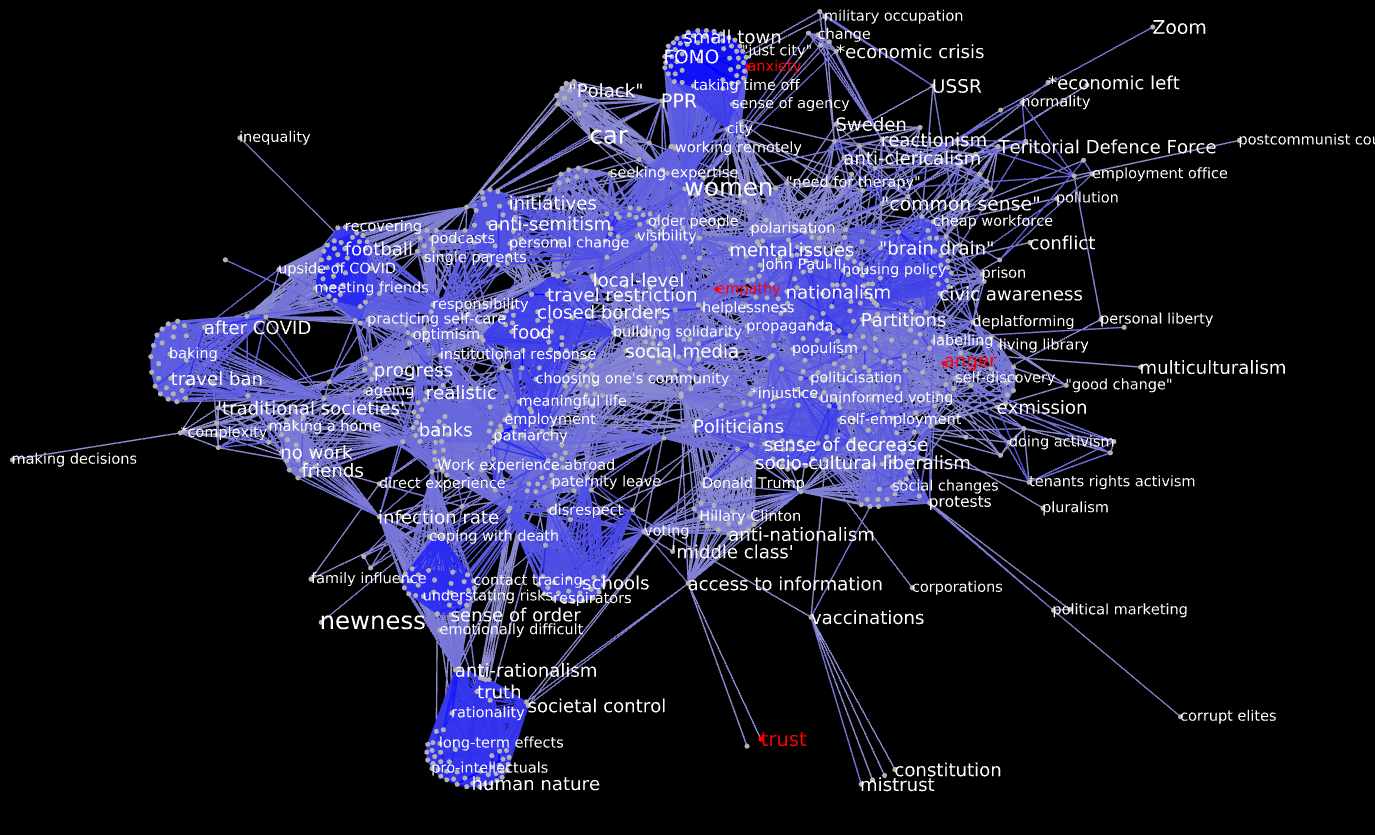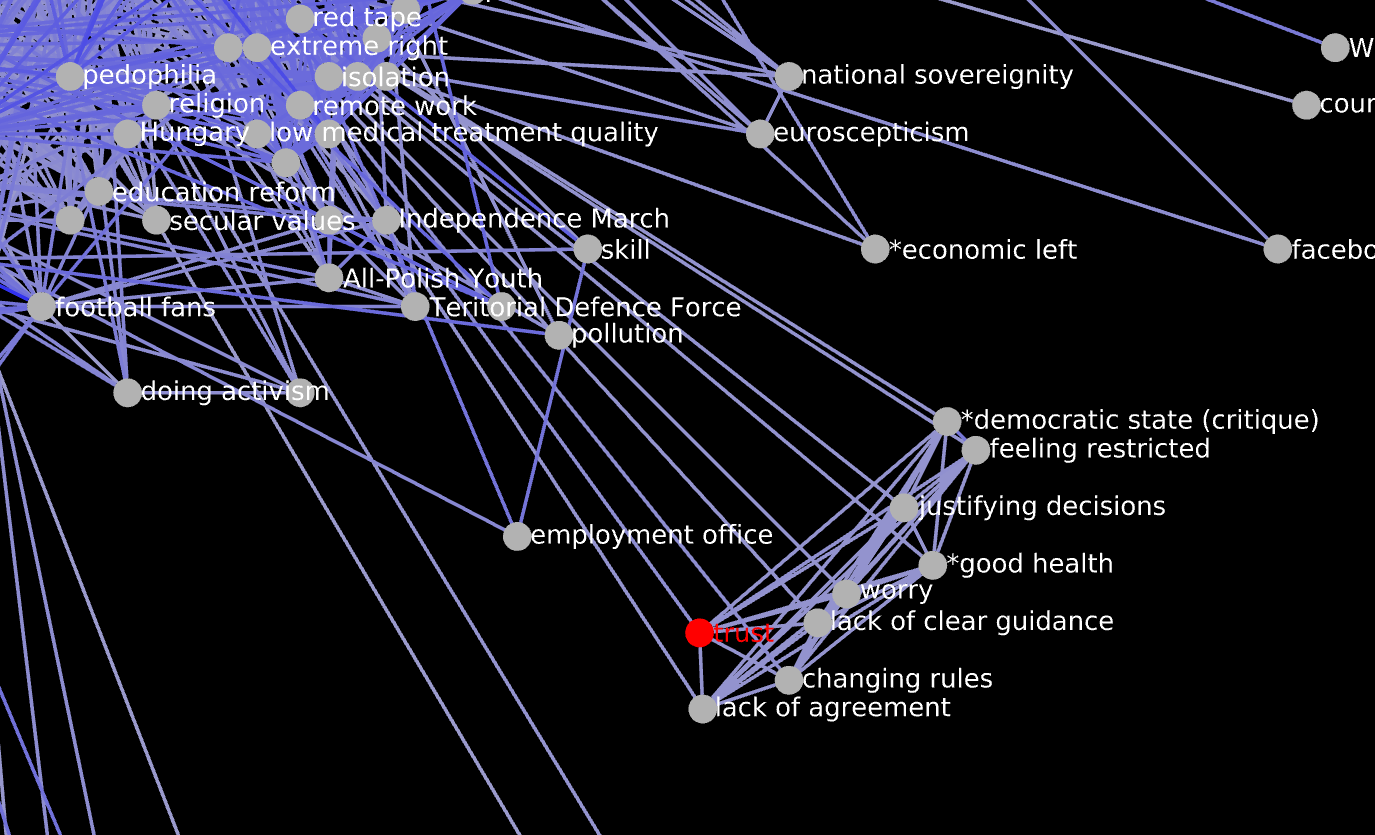This is an attempt on a preliminary analysis supporting the presentation by Boda Zsolt at the POPREBEL policy event.
“Preliminary” is an important disclaimer, because we have not done a data audit yet. I have, however, cleaned up the #ethno-icqe2022 part of the corpus, and added it to the main #ethno-poprebel corpus. The latter consists of 5,904 contributions in 499 topics, for a total of 809,000 words. The CCN contains 1,691 codes and 46,965 (stacked) edges. The total number of co-occurrences is just over 100,000.
The research question is "how do affects surface in discussing politics in this corpus? @Nica and I decided to do a sort of ego network analysis, much like we did in the ICQE22 paper. She chose five codes; their ego networks should provide the beginning of an answer. The four are:
trustanxietyangerempathy
I have chosen to reduce by Simmelian backbone, for two reasons. The first: Simmelian backbones emphasize closely-knit communities of codes. By looking at other codes in the same communities, we can catch an idea of the kind of “company” our starting codes keep. In theory, we could do this with other reduction techniques too, but those would focus on high-depth and high-breadth edgeds rather than on the (relatively unreduced) communities to which these codes belong. I write “relatively unreduced” because Simmelian backbone extraction reduces the edges bridging across communities, leaving closely-knit communities more or less intact.
The second reason: these codes do not belong to very deep or very broad edges.
Below is a visualization of the CCN’s Simmelian backbone with r > 24 (850 codes, 14,708 edges). This is the highest value of r for which all four codes still appear. The maximum redundancy value of incident edges to each code is a rough indicator of how closely-knit (in the Simmelian sense) is the community to which that code belongs. These values are:
-
anxiety: 66 -
anger: 32 -
empathy: 31 -
trust: 25

1. anxiety
The easiest one is anxiety, which is part of a tightly-knit community even at these high levels of edge redundancy. Besides anxiety itself and two meta-codes ( Z Emotions - Category), it contains 74 other codes.
list of the codes in the same community as `anxiety` with *r* > 24 (`anxiety` itself is omitted)
military occupation
labour
working remotely
city
big cities
variety
pressure to succeed
sense of purpose
daily routine
sense of personal space
despondency
placemaking
equity
inadequate income
irrationality
historical traumas
police brutality
anxiety
increasing use
gentrification
public space
sense of loss
FOMO
bilingual
chance encounter
urban geography
belonging
intersectionality
freelance work
improving places
following passion
cultural diversity
democracy
motivation
village
small changes
unemployment
sense of agency
EU
PPR
urban infrastructure change
"just city"
feminist geography
delayed projects
social life
social engagement
performing rituals
women
mindfulness
anti-ownership
encountering difference
ignoring rules
cosmopolitan
racism
self-worth
recognising shared humanity
*sense of safety
small town
lack of involvement
'happiness'
bodily reaction
taking time off
Since I have later used the threshold value of 20 for r, here is a list that does the same, biut with edges for which r > 20. There are about 30 extra codes, but the flavour does not seem to change to my untrained eye.
list of the codes in the same community as `anxiety` with *r* > 20 (`anxiety` itself is omitted)
political inaction
public space
irrationality
racism
Germans
*frustration
sense of agency
women
big cities
self-worth
police brutality
vaccinations
sense of threat
EU
FOMO
working remotely
inadequate income
social engagement
unemployment
*economic crisis
despondency
*sense of safety
cosmopolitan
taboo
support groups
homosexuality
daily routine
mindfulness
change
police state
small town
village
city
social life
labour
freelance work
taking new approach
'good examples to follow'
visibility
suppression
ignoring problems
taking individual action
'alone against the system'
self-righteous
political problems
'escape from problems'
environmental problems
initiatives
"hard to plan ahead"
instrumentalisation of social problems
left-wing politics
wybory życiowe
educational inequality
ignoring rules
eliciting emotions
democracy
sense of community
self-actualisation
recognising shared humanity
security
sense of loss
chance encounter
encountering difference
belonging
*building communities
delayed projects
small changes
sense of decrease
deliberate desensitization
pessimism
cultural diversity
following passion
variety
'happiness'
urban infrastructure change
gentrification
sense of personal space
bodily reaction
increasing use
performing rituals
sense of purpose
pressure to succeed
motivation
intersectionality
equity
"just city"
lack of involvement
anti-ownership
improving places
placemaking
taking time off
bilingual
urban geography
feminist geography
2. trust
trust has only one edge connecting it to the reduced CCN when r > 24 (it goes to access to information). However, if I reduce slightly less (r > 20), I get it as part of another very clear community:

list of the codes in the same community as `trust` with *r* > 20
access to information
feeling restricted
worry
*democratic state (critique)
changing rules
*good health
lack of clear guidance
lack of agreement
justifying decisions
3. empathy
I did the same thing with empathy, except that I chose a lower threshold value (r > 20) to include some extra codes. At this level of reduction, empathy has 20 neighbors. I should emphasize that these neighbors are not exacly a community in the sense of the very clear cluster that anxiety is part of.
list of the codes connected to `empathy` by edges with *r* > 20
world is your oyster
lockdown
(lack of) affordable housing
tolerance
privilege
Catholic Church
France
coping with death
salary satisfaction
internet users
escaping "bubbles"
"bubbles"
emotionally difficult
traditional values
homophobia
judgmental culture
mental issues
alleviating polarisation
seeking civilised debate
sexism
4. anger
I treated anger in the exact same way as empathy.
list of the codes connected to `anger` by edges with *r* > 20
wyjaśnienie naukowe
entrepreneurs
consumerism
education system
WHO
vaccinations
lockdown
government inefficiency
mental issues
pedophilia
*depression
disappointment
private healthcare
religious upbringing
climate change
cynicism
demonization
financial crisis
spirituality
NGOs
pandemic
privilege
universities
parenting
unpaid labour
@nica, any thoughts?